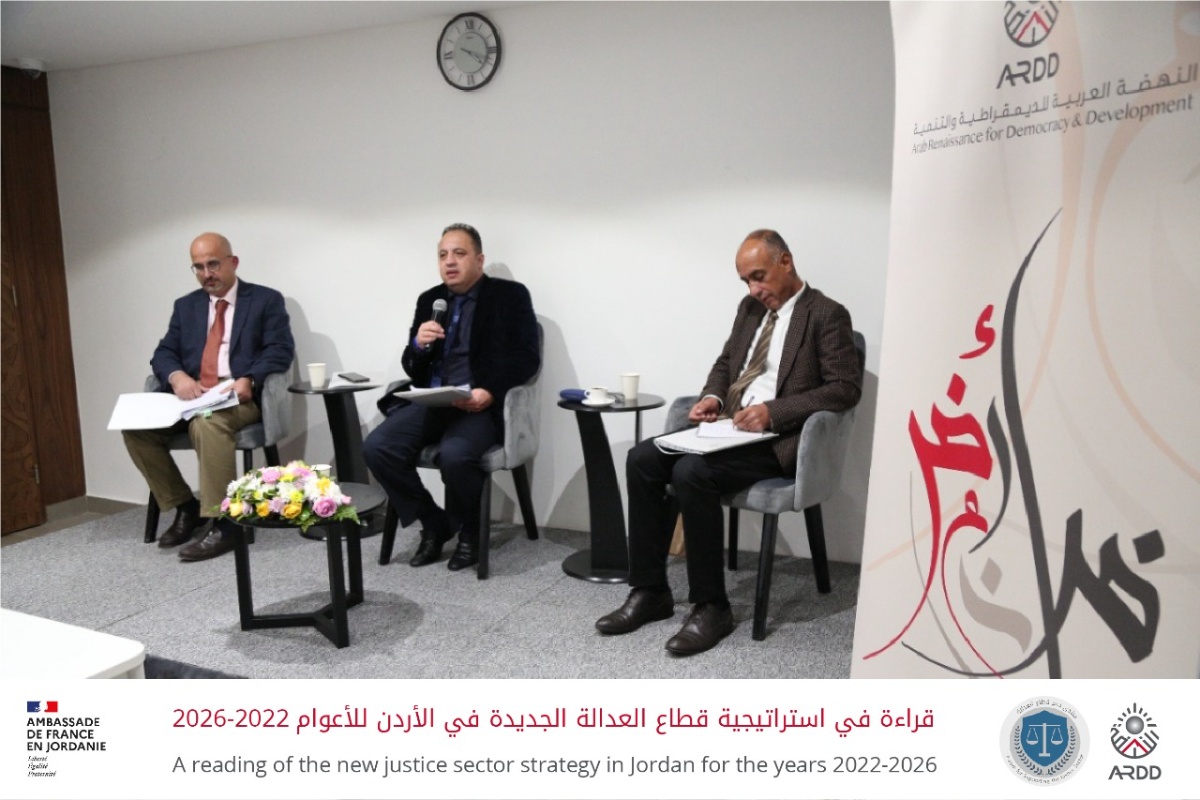On August 23, 2022, the Judicial Council and the Ministry of Justice launched the justice sector strategy for the years 2022-2026, which is based on five main pillars: developing legal procedures, improving the judicial and law enforcement systems and their human resources, enhancing access to justice, developing infrastructure, and updating legislation. In line with the intersectionality of the justice sector, the rule of law, and the right to access comprehensive justice, ARDD’s Justice Forum held a dialogue session to explore the strategy’s pillars and their implementation mechanisms. It examined the role of official and unofficial bodies in implementing and promoting the rule of law, setting general expectations for the strategy, and ensuring an infrastructure adequate for all community groups and that eliminates social and economic obstacles to access to justice.
The session was part of the “Strengthening the Public Trust in the Justice Sector Through Social Dialogue Project” implemented with the support of the French Embassy in Amman. Participants included former judge and legal expert Jihad Doraidi and faculty member at Jordan University’s Law department Suhail Haddadin; the session was run by Riyad Al Soboh, consultant on human rights.
Soboh stressed the importance of the session in assessing the situation of justice and human rights. The session linked analyzed and critiqued the justice sector strategy for the years 2202-2026. Soboh said that the strategy overlooked many recommendations from recurrent reviews and international human rights reports, which it ought to consider if it were to progress.
Doraidi said that the public’s trust in the justice sector can only be strengthened through actions, not strategies. A strategy, he said, cannot be introduced without the evaluation of its precedents and the publication of said evaluation results. Doraidi zoomed in on the infrastructure aspect of the strategy, and said that it has not been developed well enough nor is it at the level required by the justice sector.
According to him, calls for improving the infrastructure have been made for decades, with little to no change. While the global trend is to focus on the structural engineering of courts in Jordan, most buildings are rented and do not adhere to regulations. For example, in the Criminal Court defendants are placed at the far end of the 12-meter-long room, far away from the judge, lawyer, prosecutor, and witnesses, which means no one can hear the others properly, which is a violation of the regulations of the justice system.
Neither did amendments consider the nature of human resources, he added.
“If the issue is practices, then amendments are not the answer, but training for all involved staff,” he said.
Speaking about the development of regulations, Doraidi said: “Issues should be fixed with appropriate measures. Amendments relevant to digital linkage of institutions addressed many issues. However, amendments cannot focus on resolving cases quickly at the expense of denying defendants the right to defend themselves. The justice sector’s essence is finding the truth, and judges taking their time to reach it is all we need.”
Haddadin criticized the absence of academic and human rights organizations and law professors and practitioners in drafting the strategy.
According to him, “the strategy did not follow Descartes’ approach to defining the problem and finding a solution to it, instead, it kept mixing subgoals with strategic goals and repeating indicators and procedures.” The strategy may include many issues, including stress on capacity development, but fails to specify its objective or end goal, and in mentioning civil justice, it did not take into consideration lesser demands.
He added that Jordan’s real problem is that the judiciary is divided into magistrates’ courts and administrative courts, which confuses the public. Another problem is the absence of public prosecution in the process of developing the strategy. Neither was there mention of percentages of convictions and the performance of prosecutors.
Participants stressed that it is important for decision makers to lend an ear to civil society organizations, unions, and human rights organizations, as experts in the area of the justice sector. They reiterated the importance of enhancing comprehensive access to justice in all fields, including that of economic and social rights, as well as the need to continuously develop infrastructure, human resources, regulations, training, update cost of services and secure supportive services such as legal aid.


